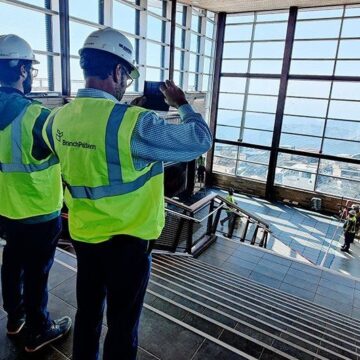Sierra Grande: How a Rural Colorado District Found a Way to Build an All-Electric, Net Zero Energy School
- Perspectives
When BranchPattern is engaged to help build or remodel a school, we advocate for Net Zero Energy (NZE) every time. However, it’s not often we see a NZE school realized in the final deliverable. The main reasons are:
- Money NZE schools can be perceived as more expensive construction costs and more expensive to maintain.
- Maintenance NZE schools can require a complicated mechanical system, which calls for an operations team to learn how to maintain and operate a new system.
For instance, many NZE schools around the country utilize geothermal as the main mechanical system. However, geothermal in Colorado has proven to be an unrealistic option due to the high cost of drilling, which reinforces the first-time cost issues mentioned above. Geothermal equipment (or other extremely energy efficient mechanical systems) is expensive to install and replace.
The lifespan of mechanical equipment is typically only 15-20 years, meaning that school districts that utilize more expensive equipment are responsible to pay a premium every two decades, which is not a great return on investment. The parts of the system also require specialized installation from companies that are far from a rural school, which also adds to the expense and difficulty in operation.
Through thoughtful and collaborative planning between Cuningham Group, Sierra Grande School District R-30 and BranchPattern, we have proven that an all-electric NZE PK-12 school facility can come in on-budget, on-time and be easy to operate.

To help the Sierra Grande school, located in rural Blanca, CO, achieve NZE, our team first focused on meeting aggressive sustainability goals, which were a requirement of the grant, and keep first-costs and ongoing maintenance costs low. Cuningham architects and BranchPattern engineers modeled different types of mechanical and architectural systems to discover how they best worked together. We realized that if energy-efficiency efforts focused on the building’s envelope, which are the architectural systems that include windows, walls, roof, and slab, the team could utilize Passive House strategies and requirements to reduce the heating and cooling loads tremendously.
For example, typical high-performance schools include R-20 in the walls, and at Sierra Grande the walls are designed with R-50. This is accomplished through utilizing prefabricated panels which avoids insulation installation issues on-site. By utilizing this strategy, the loads were reduced so much so that ventilation air, or outside air, will be used to cool the space even in winter.

Unlike a mechanical system, the envelope will likely never have to be replaced. While super-insulated panels and triple-glazed windows might cost more upfront, they do not require ongoing maintenance fees. Since the heating and cooling loads were substantially reduced, the potential mechanical system was flexible.
Our team received cost estimates on several different systems from the mechanical contractor and were not locked in to one single system (like geothermal). The mechanical system that was selected is VAV (Variable Air Volume) with electric reheat with displacement ventilation. This type of system is more common, less costly to install, and easier to replace, as compared to other high-efficiency systems. We also chose a system for its ease of use, making it very simple for the district staff to maintain and operate.

Thinking beyond just NZE, our team wanted to extend sustainability goals to include fossil fuel reduction. We analyzed the possibility of making the school 100% electric. There is no renewable fuel source for natural gas. And, more district-wide electric grids are utilizing renewable energy, like solar, to power the entire grid. Therefore, the faster buildings convert to 100% electricity with zero dependence on natural gas, and the faster energy grids transition to renewable energy sources, the sooner buildings will no longer rely on burning fossil fuels. This is extremely important to reducing global carbon emissions and mitigating climate change.
At Sierra Grande, the heating loads came in so low due to the massive investment in the building envelope. All heating could be done through electricity rather than needing a connection to natural gas. This eliminated the need for a natural gas hook-up, further reducing costs because an entire utility service line and additional equipment were eliminated from the scope.
Finally, our team saved the client enough money by investing in architectural systems, the cost of on-site solar panels could fit into the original project budget. Often times NZE schools are actually only “NZE ready.” Meaning the energy consumption is so low that once the district can install on-site solar panels they will then be officially NZE. In most “NZE ready” cases, solar panels are not installed for many years, if at all. BranchPattern’s strategy is to advocate for solar panels as a part of the original project budget on NZE projects. For Sierra Grande, we were able to prove that cost savings from the mechanical system were enough to fit on-site solar panels into the construction budget.
Cuningham and BranchPattern are excited for Sierra Grande’s NZE accomplishments. By working together early on to help clients realize goals, no matter how aggressive, we can devise custom solutions for our clients. We hope this approach to NZE schools serves as a model to more districts and schools throughout the country. A true NZE all-electric school is possible without added cost or complicated systems.





